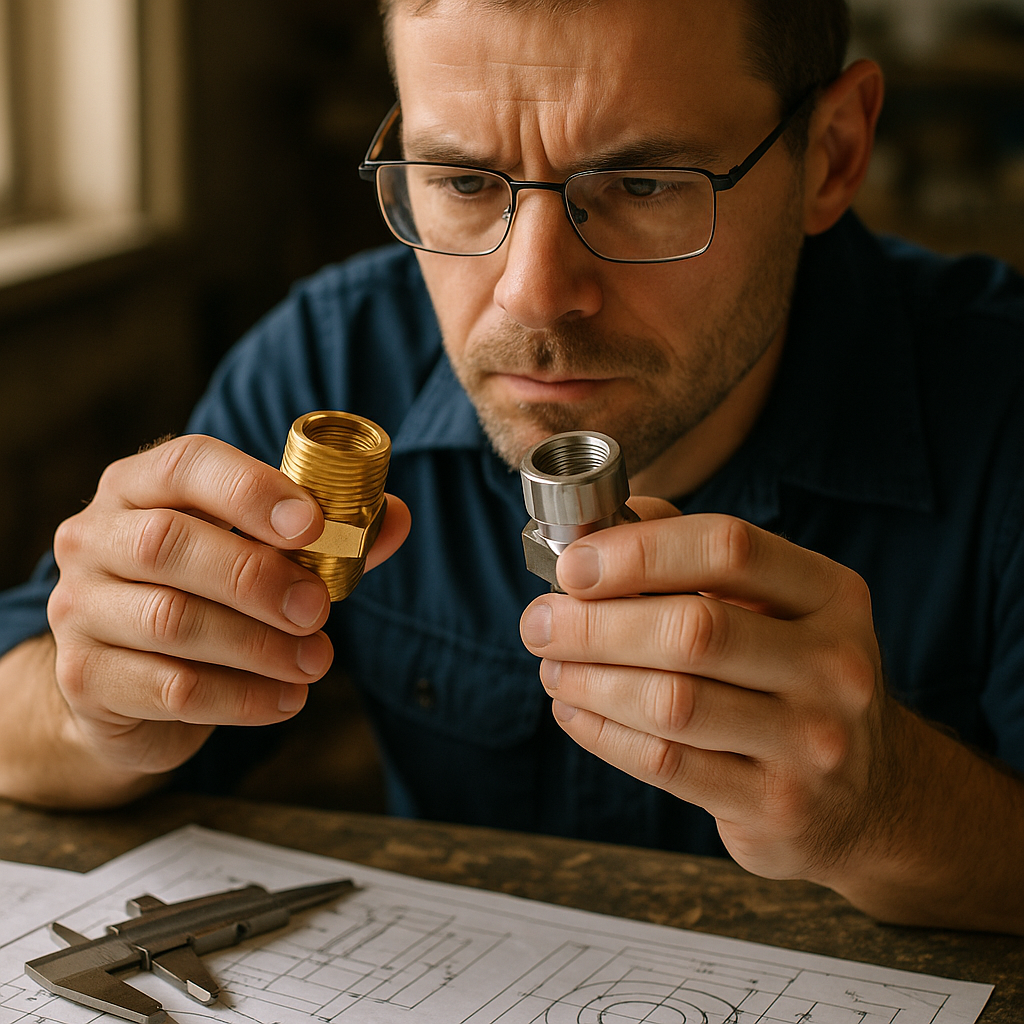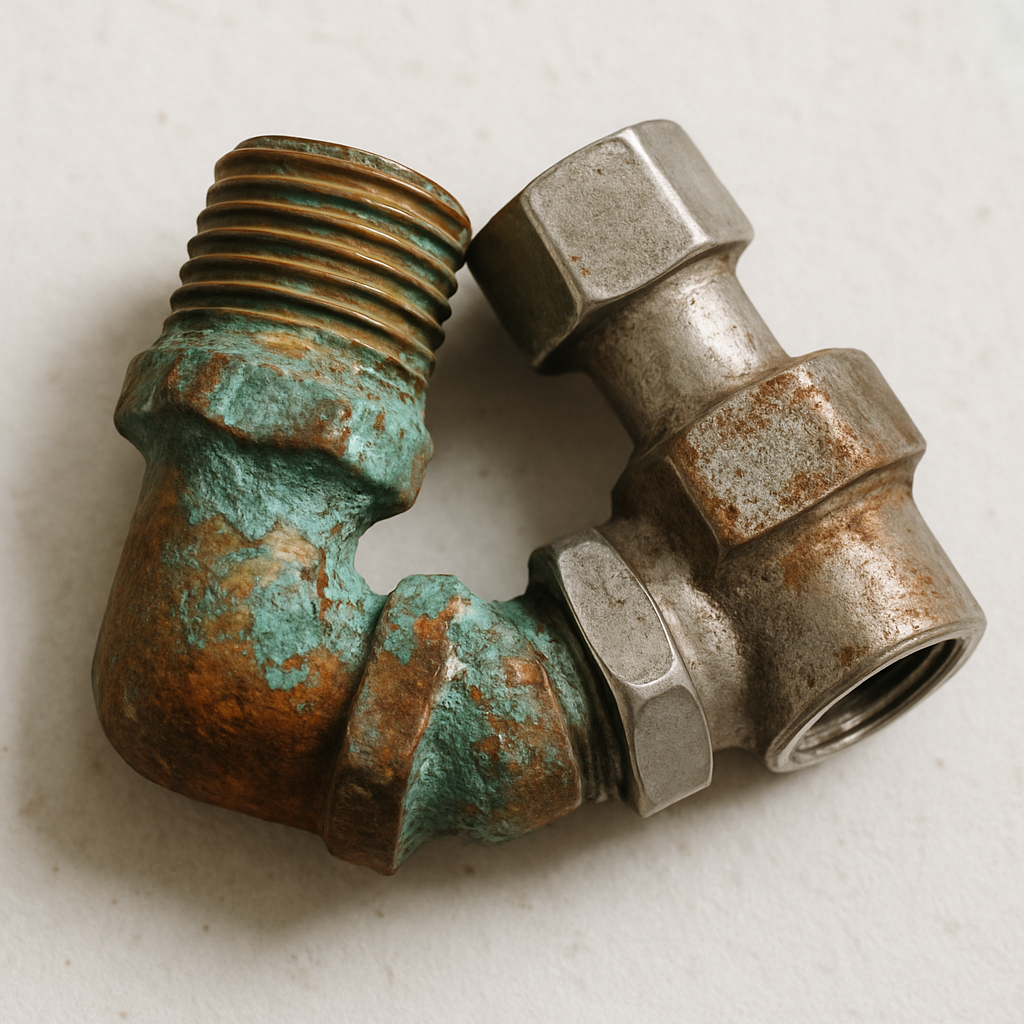5901 Botham Jean Blvd, Dallas, TX 75215
Stainless to Brass: Compatibility, Corrosion Risks & Fixes
September 22, 2025In plumbing and industrial systems, the decision to mix stainless steel and brass fittings is often driven by cost considerations, material availability, or specific application requirements. Professionals regularly face this choice when assembling fluid-carrying systems. Assessing the compatibility between these two dissimilar metals is complex and requires understanding their physical and chemical properties.
When improperly combined, these materials can create significant problems. Galvanic corrosion occurs when metals with different electrical potentials connect in the presence of an electrolyte like water. This electrochemical reaction can lead to accelerated deterioration of components, system failures, and costly repairs. Thus, proper connection methods, appropriate sealing techniques, and correct fitting selection become critical for system longevity.
Beyond corrosion concerns, differences in thermal expansion, pressure ratings, and thread compatibility also affect how these materials interact. Understanding these factors helps prevent leaks, joint failures, and maintenance challenges. With the proper knowledge, professionals can successfully integrate these materials while avoiding the pitfalls that come with improper installation techniques.
What Are the Key Compatibility Factors to Consider?

When combining brass and stainless steel fittings, several critical factors determine their effective compatibility or the potential for problems in your system. Understanding these factors helps prevent premature failure and ensures optimal performance across various applications.
Galvanic Corrosion Potential
Galvanic corrosion occurs when two dissimilar metals connect in the presence of an electrolyte like water or moisture. In a brass-stainless steel connection, stainless steel acts as the cathode (more noble) while brass becomes the anode. This electrochemical relationship accelerates the corrosion of brass components.
The position of these metals in the galvanic series is crucial. Stainless steel grades like 316 and 304 rank higher in nobility than brass alloys. A greater difference in electrochemical potential leads to faster corrosion. Practically, a small brass fitting attached to a large stainless steel component will corrode more quickly due to the unfavorable surface area ratio.
Chemical Interactions
The fluid composition passing through mixed fittings significantly impacts compatibility. Certain chemicals common in industrial processes or water sources react differently with brass and stainless steel. Chlorides, sulfates, and acids can affect the protective oxide layers on these materials, potentially leading to localized corrosion or pitting.
For instance, brass fittings generally resist many corrosive substances but may undergo dezincification in aggressive water conditions, leaching zinc from the brass and compromising its structural integrity. Stainless steel, particularly grade 316, offers superior resistance to chlorides and salt environments compared to brass or stainless 304.
Temperature also affects chemical interactions. Higher temperatures accelerate chemical reactions, potentially increasing corrosion rates in mixed-metal systems. This is crucial in high-temperature applications, where brass has a maximum temperature rating of around 400°F, and stainless steel can withstand up to 1200°F.
| Factor | Brass | Stainless Steel |
| Galvanic Corrosion Potential | Higher risk as anode; corrodes faster when paired with stainless steel | Acts as cathode; more noble and increases corrosion risk for brass |
| Chemical Interactions | Prone to dezincification in chloride and sulfate environments; lower maximum temperature tolerance (~400°F) | Better resistance to aggressive chemicals such as chlorides and sulfates; higher maximum temperature tolerance (~1200°F) |
| Environmental Conditions | Higher risk in marine/coastal environments due to salt acting as an electrolyte | More resistant to environmental changes; performs better in the same environments |
| Surface Area Considerations | Corrodes faster with smaller surface area relative to a stainless steel component | Larger relative surface area decreases corrosion influence from brass component |
Environmental Conditions
The external environment significantly influences brass-stainless steel compatibility. Humidity levels, exposure to salt air, and temperature fluctuations all play major roles in determining corrosion risk.
Marine and coastal environments pose the greatest risk for mixed fittings due to salt’s corrosive nature. Salt acts as an effective electrolyte, accelerating galvanic corrosion between brass and stainless steel. Indoor, dry environments present much lower risks than outdoor installations exposed to weather elements.
Stagnant water or dirt accumulation can trap electrolytes between metal connections, creating persistent corrosion conditions. Proper drainage and installation techniques are critical factors in the longevity of mixed-metal systems.
Surface Area Considerations
The ratio of surface areas between brass and stainless steel significantly influences corrosion rates. A small brass component connected to a large stainless steel surface will corrode more quickly than if the size relationship were reversed.
This occurs because the current density at the smaller anode (brass) increases when paired with a larger cathode (stainless steel). For more balanced systems, engineers recommend minimizing the cathode-to-anode surface area ratio whenever possible.
What Are the Potential Risks of Mixing Brass and Stainless Steel?

When brass and stainless steel fittings are connected in recycling equipment or water systems, they can create significant problems affecting both operational efficiency and material recovery. The primary concern is galvanic corrosion, which occurs when these dissimilar metals make electrical contact in the presence of an electrolyte like water.
Galvanic Corrosion Acceleration
Brass and stainless steel occupy different positions on the galvanic series, creating an electrochemical reaction when connected. Brass, typically the anode, corrodes faster due to its more negative electrode potential compared to stainless steel.
The severity of this corrosion depends on several factors. In recycling facilities, where water is used for sorting and cleaning materials, the risk increases significantly. The water’s electrical conductivity, especially when containing dissolved minerals or processing chemicals, speeds up corrosion.
Surface area ratios between metals also play a crucial role. For instance, a small brass fitting attached to a large stainless steel pipe can result in accelerated brass corrosion, as the corrosion current concentrates on a smaller area.
Material Degradation and System Failures
As galvanic corrosion advances, brass components may undergo dezincification, selectively removing zinc from the alloy and leaving a porous, weakened structure. This process leads to visible signs such as greenish deposits on brass surfaces, pitting, and erosion around threads or valve seats.
In recycling operations, where material flow must remain consistent, degradation can lead to system failures at critical points. Joints weaken, threads fail, and leaks develop. Water-based sorting systems or hydraulic equipment may experience pressure drops, reduced flow rates, and ultimately component failure.
Material handling systems using mixed-metal components in humid environments face similar risks, even without direct water contact, as ambient moisture can act as an electrolyte to initiate corrosion.
Reduced Longevity and Increased Maintenance Costs
Recycling facilities often encounter shorter operational lifespans for systems using improperly matched brass and stainless steel fittings compared to properly designed installations. What might have been a 20-year service life can reduce to just a few years in severe cases.
The financial impact extends beyond replacement costs. Unplanned downtime during component replacement disrupts recycling operations, potentially causing backups in material processing. Maintenance teams must conduct more frequent inspections, accelerating repair schedules compared to well-matched systems.
For operations with limited resources, these increased maintenance demands can significantly impact operational budgets and sustainability goals.
Safety and Environmental Risks
Beyond operational concerns, galvanic corrosion between brass and stainless steel presents safety risks. Failed components in pressurized systems can result in sudden fluid or pressure releases. In facilities processing hazardous materials, such failures might expose workers to harmful substances.
Environmental concerns also arise when corroded fittings leak processing fluids, potentially requiring additional treatment before discharge and creating further waste management challenges. Premature replacement of corroded components contradicts sustainability principles by increasing material consumption and waste generation.
In water recycling systems, corrosion byproducts can contaminate process water with metal ions, potentially affecting the quality of recycled materials or necessitating additional filtration steps.
| Condition | Brass | Stainless Steel | Considerations |
| Galvanic Corrosion | Anode (more susceptible) | Cathode (less susceptible) | Use dielectric unions to prevent direct electrical contact |
| Chemical Resistance | Susceptible to chlorides, dezincification | Better resistance, especially grade 316 | Avoid mixing with high chloride or acidic solutions |
| Temperature | Max 400°F | Max 1200°F | Utilize where high temperature resistance is not critical |
| Environmental Suitability | Indoor, less humid environments | Good for marine and aggressive conditions | Surface protection required in harsh environments |
Real-World Impact in Recycling Operations
Several recycling facilities have reported significant issues from improper metal pairings. In one paper recycling operation, brass valves connected to stainless steel pipes in the pulping system failed after just eight months of operation, resulting in lost processing capacity and costly emergency repairs.
Similarly, an electronic waste recycling facility experienced repeated failures in its washing system where brass fittings connected to stainless steel components. The facility eventually replaced all mixed-metal connections with compatible alternatives, eliminating the recurring issue and improving system reliability.
Plastic recycling operations using water-based separation systems have reported similar challenges when brass valves corroded at connection points with stainless steel piping. This not only disrupted operations but also contaminated sorted materials with metal particles.
Preventing Corrosion with Proper Design
Preventing galvanic corrosion requires thoughtful system design. For recycling operations, selecting metals with similar electrode potentials reduces corrosion risk. When brass and stainless steel must be used together, dielectric unions or insulating fittings can break the electrical connection between them.
Protective coatings on the more noble metal (stainless steel) can also reduce galvanic effects. Regular inspections help identify early signs of corrosion, allowing for intervention before catastrophic failure occurs.
When designing new recycling systems or upgrading existing ones, consulting with materials specialists helps ensure proper metal compatibility, preventing costly failures and extending system lifespan.
What Are the Best Practices for Mixing Brass and Stainless Steel Fittings?

Mixing brass and stainless steel fittings in plumbing and industrial systems requires careful consideration to prevent premature failure. When these dissimilar metals meet in the presence of an electrolyte like water, galvanic corrosion can occur. This reaction accelerates the degradation of the more anodic metal (typically brass). Fortunately, several strategies can minimize these compatibility issues.
Use of Dielectric Unions
Dielectric unions are specialized fittings designed to separate dissimilar metals within a piping system. These unions incorporate non-conductive materials (usually plastic or rubber) that prevent direct metal-to-metal contact. By breaking the electrical pathway between brass and stainless steel, they significantly reduce the risk of galvanic corrosion.
When installing dielectric unions, ensure they’re placed at every junction where brass meets stainless steel. This creates an effective barrier that extends the lifespan of both materials and maintains system integrity. For maximum effectiveness, verify that the unions are rated for your specific application’s pressure and temperature requirements.
Applying Insulating Materials
In situations where dielectric unions aren’t feasible, applying insulating materials between the dissimilar metals provides an alternative. Non-conductive gaskets, washers, or thread tape create barriers that minimize electrical contact. PTFE (Teflon) tape is particularly useful for threaded connections, while rubber or plastic washers work well for flanged joints.
When applying insulating materials, ensure complete separation between the metals. Even small areas of direct contact can create conditions for galvanic corrosion. Regular inspection of these insulation points is recommended, as degradation of the insulating material over time can reestablish metal-to-metal contact.
Material Selection Based on Application
Careful material selection significantly impacts mixed fittings’ compatibility. When choosing brass and stainless steel combinations, consider their position on the galvanic series. The metals should have electrochemical potentials within 0.15-0.25V of each other to minimize corrosion risk.
Certain combinations perform better than others. For example, brass paired with 301, 304, or 310 stainless steel typically works well because they are relatively close on the galvanic scale. Conversely, brass combined with 410 stainless steel is more problematic due to their greater separation on the galvanic index. Always verify compatibility based on specific material grades rather than general categories.
Environmental Considerations
The operating environment significantly impacts how mixed fittings perform. Water quality, temperature, pressure, and chemical exposure all influence galvanic corrosion potential. Systems with aggressive water conditions (high mineral content, chlorides, or pH extremes) require additional protective measures when mixing materials.
In high-temperature applications, thermal expansion differences between brass and stainless steel can stress connection points. Compensate for this by using flexible connections or expansion joints where appropriate. For systems exposed to frequent temperature cycles, ensure connections can accommodate repeated expansion and contraction without compromising seals.
Installation Guidelines
Proper installation techniques are crucial when mixing brass and stainless steel fittings. Start with thoroughly cleaned surfaces, removing any debris, oils, or contaminants that could interfere with connections or accelerate corrosion. Use appropriate thread sealants compatible with both materials.
Apply the correct torque when tightening connections. Over-tightening can damage threads or compromise dielectric unions, while under-tightening may lead to leaks. Follow manufacturer specifications for torque values and tightening sequences. Consider using calibrated torque wrenches for critical applications.
Thread compatibility is another important consideration. Ensure that the threads of brass and stainless steel components match properly. In some cases, adapters with compatible thread types may be necessary to achieve proper sealing and prevent leaks.
Regular Inspection and Maintenance
Even with proper precautions, connections between dissimilar metals require regular monitoring. Implement a schedule for inspecting mixed-material junctions, looking for early signs of corrosion, discoloration, or leaks. Catching problems early allows for intervention before catastrophic failure occurs.
Document the locations of all mixed-material connections in your system for easier tracking and maintenance. Keep records of installation dates, materials used, and any protective measures applied. This information proves invaluable for troubleshooting issues or planning system upgrades.
Maintenance should include periodic testing of water quality parameters that influence corrosion, such as pH, chloride levels, and dissolved oxygen content. Adjust water treatment programs as needed to maintain conditions that minimize galvanic effects.
| Factor | Brass | Stainless Steel | Considerations |
|---|---|---|---|
| Galvanic Corrosion Potential | Acts as anode; higher corrosion risk when paired with SS | Acts as cathode; relatively lower risk | Use dielectric unions or insulating materials to prevent direct contact |
| Chemical Interactions | Resistant to many corrosive substances, but susceptible to dezincification | Superior resistance, especially in chloride-rich environments | Match materials based on the specific chemicals |
| Temperature Resistance | Up to 400°F | Up to 1200°F (depending on grade) | Consider thermal expansion differences in applications with temperature fluctuations |
| Cost and Availability | Generally less expensive | Usually more costly | Balance cost against the lifespan and application needs |
| Material Longevity | Prone to dezincification over time | More durable and resistant | Regular inspection required to handle early signs of deterioration |
Technical Considerations
Understanding the technical aspects of mixed fittings helps ensure successful implementation. For systems carrying fluids, consider flow characteristics at junction points where different materials meet. Turbulence or flow restrictions can create localized conditions that accelerate corrosion.
Pressure ratings must be appropriate for both materials. The system should not exceed the pressure rating of the weaker material, even if the stronger material could handle higher pressures. Temperature limits follow the same principle—design to the more restrictive material’s specifications.
Chemical compatibility extends beyond the interaction between the metals themselves to include the fluids being transported. Verify that both brass and stainless steel are suitable for the specific chemicals, concentrations, and temperatures present in your system.
Conclusion: Ensuring Safe and Effective Use of Mixed Materials

Although combining brass and stainless steel fittings can pose challenges, implementing effective strategies makes their use both viable and reliable. Success is achieved by understanding galvanic corrosion risks and taking measures to mitigate them. By selecting compatible material grades, using dielectric unions, and applying proper insulating techniques, these dissimilar metals can function together effectively in various applications.
System performance and longevity largely depend on thoughtful design considerations. Prioritizing the proper selection of materials based on specific environmental conditions, pressure requirements, and fluid types will significantly reduce potential complications. Regular maintenance checks for early signs of corrosion, especially at connection points, are essential for preserving system integrity over time.
For your metal recycling and waste management needs, contact Okon Recycling at 214-717-4083. Our experts can help you select the most suitable materials and design solutions for your applications, ensuring optimal performance and reliability in your systems.
